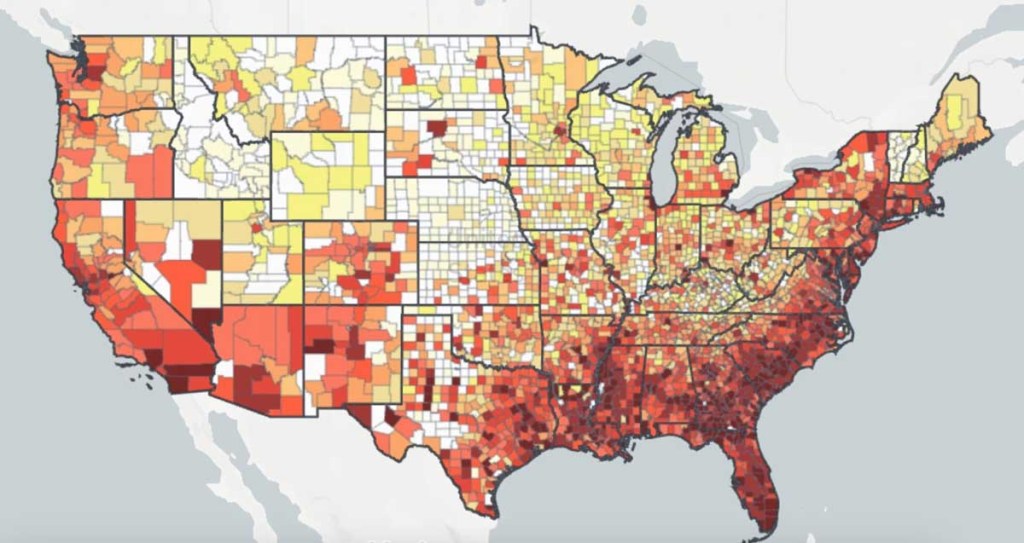Health officials look to solutions to Georgia’s high HIV rates
Published 10:52 pm Tuesday, December 5, 2023

- In the interactive map by AIDSVu, the darkest shaded areas represent highest rates of people living with HIV. The darkest red represents a rate of 438 people per 100,000.AIDSVu is presented by Emory University’s Rollins School of Public Health in partnership with Gilead Sciences, Inc. and the Center for AIDS Research at Emory University (CFAR).
ATLANTA — Health officials are brainstorming ways to help curb HIV cases in Georgia. The state is ranked second in the nation for the virus rate, after Washington, D.C.
“This affects people of all genders, all races and ethnicities and all ages,” said Lauren Middlebrooks of Emory University School of Medicine. “We continue to have high rates of new HIV diagnoses and unfortunately we are seeing those high rates in children, starting at age 13 leading through young adults up to age 34. So, these are teenagers, children and young adults that are disproportionately affected.”
Trending
The CDC reports that 26.2 per 100,000 people in Georgia are diagnosed with HIV, a virus that attacks the body’s immune system and, if not treated, can lead to AIDS. More than half of country’s diagnoses of the virus have occurred in the South.
In an effort to prevent spread of the virus, Megan Andrews, assistant commissioner for policy at Georgia Department of Public Health, said the agency will make proposals to legislators for new initiatives in 2024.
One of those is to expand the standing order authority to the DPH commissioner for post exposure prophylaxis, a drug designed to prevent HIV if taken within 72 hours of possible exposure.
If taken for 30 days, PEP significantly reduces the risk of acquiring HIV during that time period.
Andrews said the proposals comes after working with the Criminal Justice Coordinating Council and sexual assault centers, which have found it difficult to obtain PEP.
“This would provide an avenue for them to get that medication via a standing order from the commissioner. And it is something that she feels strongly will help with access,” Andrews said.
Trending
Many health departments also now have the medication PrEP, or pre-exposure prophylaxis, a daily medication for those at high risk of HIV exposure.
The state’s Medicaid covers PrEP, and 16 of 18 health districts have at least one health department that has free prEP.
Fulton County District Health Director Dr. Lynn Paxton said PrEP trials show 99% effectiveness when using it correctly.
“Obviously you have to counsel people about reducing their practices that put them at at risk,” Paxton said. “And we have to remind people this doesn’t give you a pass from using condoms. It doesn’t it doesn’t protect against syphilis or chlamydia or anything like that; this is strictly against HIV. So people should always be reminded to use a condom.”
Middlebrooks said a project she is leading at Emory suggests that adding opt-out HIV testing language at health facilities could help increase rates of testing and identify HIV cases earlier.
In 2006, the Centers for Disease Control and Prevention recommending adding opt-out HIV testing, which essentially informs the patient that HIV testing will be conducted unless the patient declines. The CDC suggests that adding opt-out testing has been shown to remove the stigma associated with HIV testing.
“So that, for example, is saying, ‘Hey, here we test everyone for HIV,’ as opposed to saying, ‘Do you want an HIV test?’ she said.
On July 6, Emory implemented its first opt-out HIV testing program in children at its two children’s facilities. Fifteen weeks before the starting the project, the group had tested approximately 450 patients. Fifteen weeks after starting the program, 650 child patients were tested. Currently five months into the program, an estimated 900 children have tested for HIV at the two Emory institutions that treat youths.
The project has found that one in every 58 teens tested is HIV positive.
Middlebrooks also referenced an Emory University study that looked at the emergency department adolescents who were seen, and later diagnosed, with HIV as a young adult.
“Of the almost 200 newly positive young adults, we saw 38 of them in our pediatric emergency department within 10 years of their diagnosis,” she said. “Many of them have been seen multiple times in our ER, and we didn’t ask them their sexual history, nor did we test them for HIV that entire time. And what’s more concerning is that about 10 of those patients probably had HIV at the time they were seen.”
If caught early, treatments could prevent late stages of HIV, or AIDS, which could be deadly.
Cases of HIV are disproportionately higher among Black adults and adolescents, who collectively comprised about 44% of new diagnoses in 2020. Hispanics were the next largest group of reported diagnoses at 26.3%, followed by white Americans, closely behind at 25.8%
HIV can be transmitted in several ways, including through sexual interactions and blood transfers.
According to the CDC, gay, bisexual and other men who reported male-to-male sexual contact accounted for 70% (22,400) of the 32,100 estimated new HIV infections in 2021. Heterosexual contact accounted for 22% of the estimated new HIV infections; and 8% of new HIV infections were among those who injected drugs.
Infected mothers can also transmit the virus to her baby during pregnancy, labour, delivery or breastfeeding.





